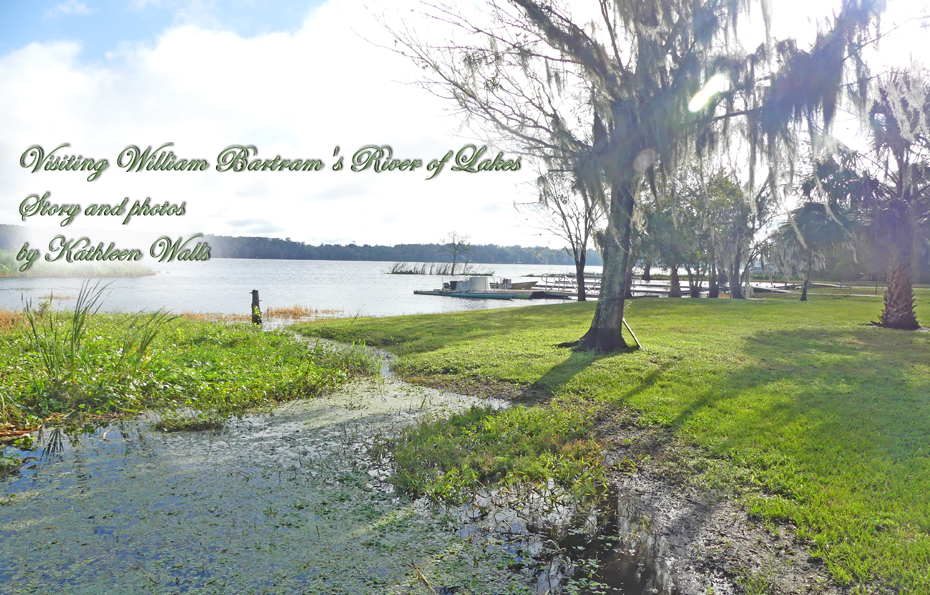|
William Bartram came to
West Volusia County 255 years ago with his
father. He was intrigued enough to return in
1774. He was one of America's first naturalists
to visit and write about Florida. His book,
Travels Through North And South Carolina,
Georgia, East and West Florida, The Cherokee
Country, The Extensive Territories of The
Muscogulges, or Creek Confederacy, and The
Country Of The Chactaws, —They went in for long
titles those days—was one of the first
naturalists' books published by the fledgling
United States in 1791.
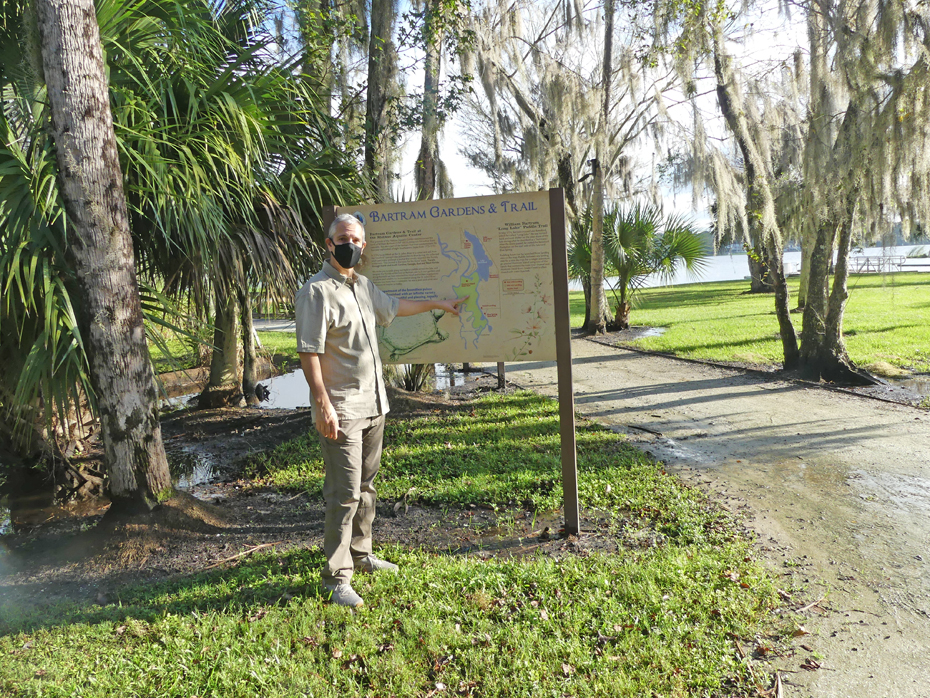 |
| Dr. Abbott
showing a sign related to Bartram's
Trail |
Now, Dr. Tony Abbott at
Stetson University in DeLand has retraced
Bartram's travels across Volusia County and
created Experience William Bartram’s Florida, a
brochure to guide you as you revisit Bartram's
sites. The perfect place to start is at Bartram
Gardens and Trail in DeLand at the Sandra
Stetson Aquatic Center. It's a ten-acre natural
area on the shores of Lake Beresford where
Bartram rested and dried out all his papers
after experienced a hurricane while traveling in
his canoe equipped with a sail. The gardens are
native plants and interpreted with signage using
copies of Bartram's original drawings.
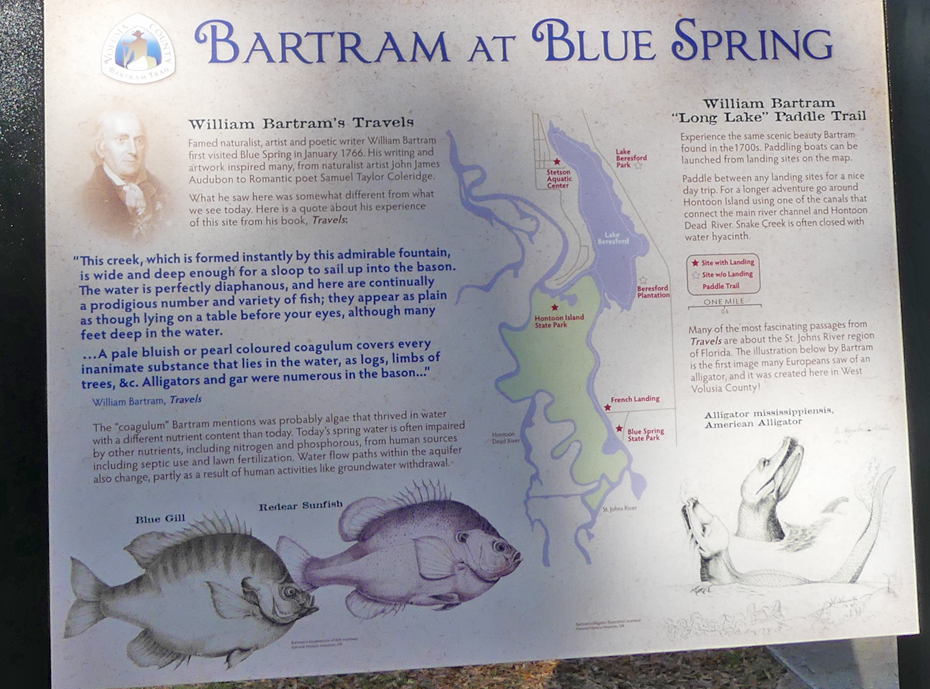
When Bartram visited he
traveled from Lake George southward towards Lake
Monroe on the Seminole County line.
Bartram Oak
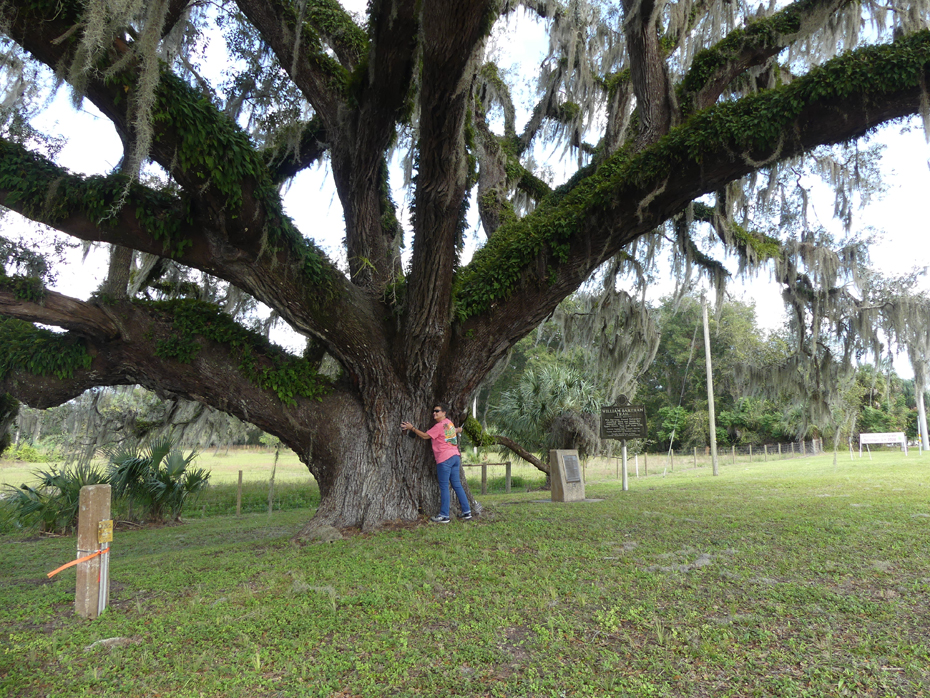
If you want to be true
to Bartram's route head for Astor and visit the
Bartram Oak on Highway 40 just east of the Saint
Johns River. Spalding Upper Indian Trade
Store, the last European settlement west of St.
Johns was just across the river. It was built
for trade with the Indians. William
Bartram spent several weeks here in May and June
of 1774. He describes "searching its environs
for curious vegetable productions, collecting
seeds and planting growing roots in boxes." The
oak would really have just been a sapling then
but he may have touched it thus the legend grew
and it became "Bartram's Oak."
Lake Woodruff
National Wildlife Refuge
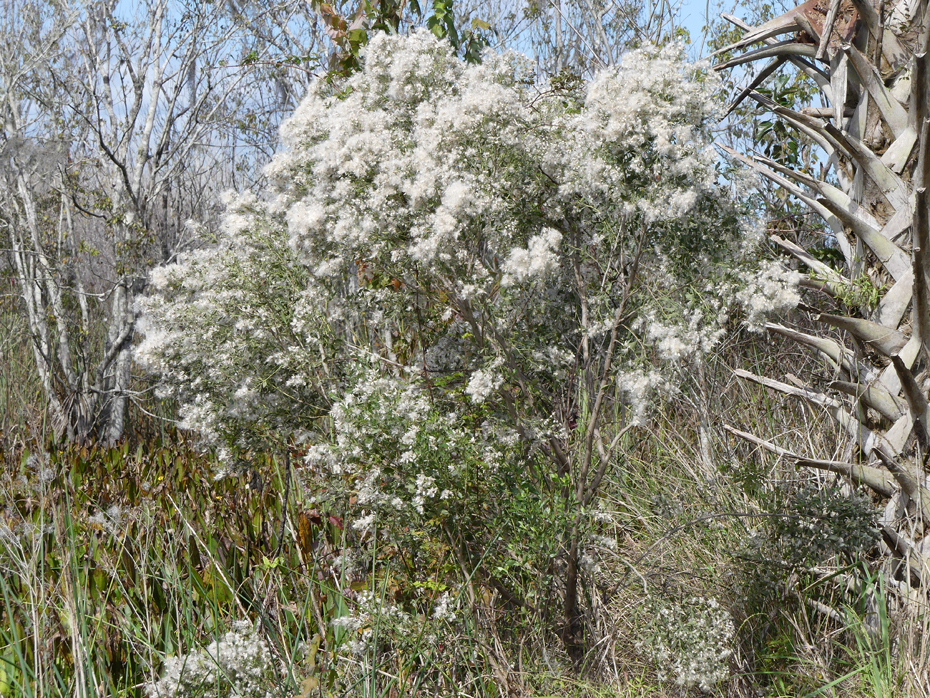
This is where the Saint
Johns River earns the name "River of Lakes. The
river forms Lake Dexter, a few smaller lakes,
and then Lake Woodruff. This group of lakes is
where Bartram describes the anhinga as "a very
curious and handsome bird, the people call them
Snake Birds"
 |
| Bartram's Snake
Bird AKA an anhinga. They must dry their
wings after diving before they can fly
again. |
It's also where he gives
an idea of the number of alligators found in
Florida before man diminished them. "The
alligators were in such incredible numbers, and
so close together from shore to shore, that it
would have been easy to have walked across on
their heads, had the animals been harmless."
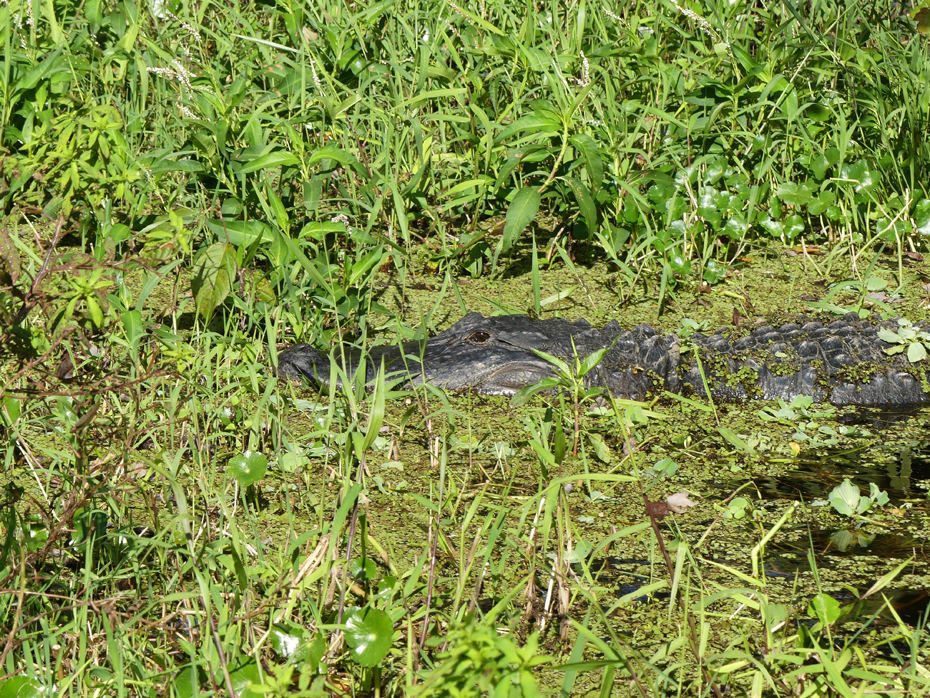
Definitely not something I would recommend but
there is a good possibility of seeing a few
alligators at Lake Woodruff National Wildlife
Refuge. In fact, you may see many species of
wildlife here. The refuge was established in
1964 as a migratory bird refuge and is a
permanent or temporary home to over 230 species
of birds. You might spot a wood stork
which is the United States' only native stork.
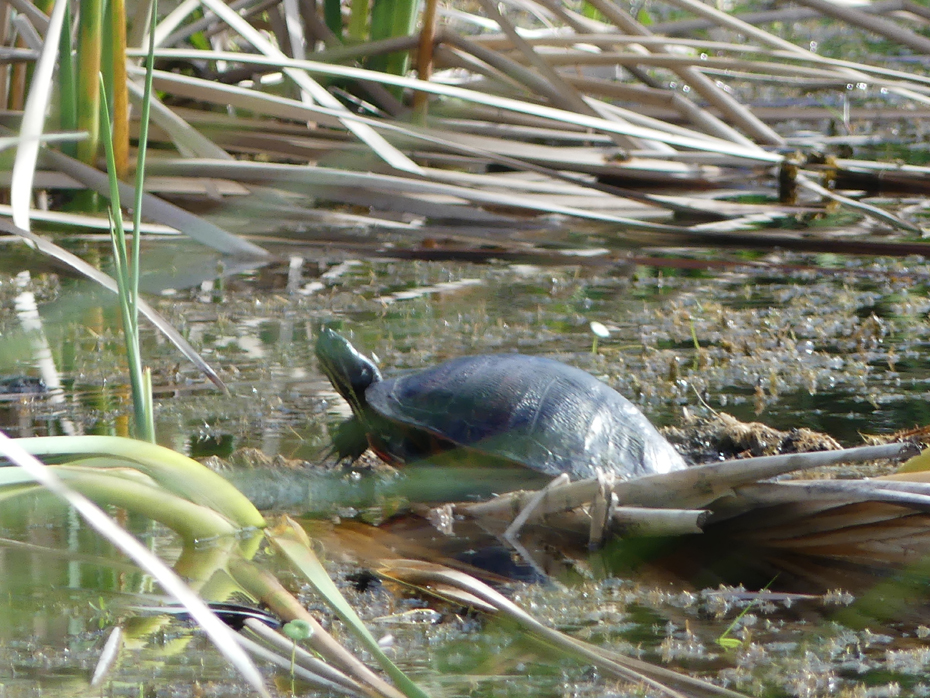
The refuge is the
second-largest pre-migration roosting point of
swallow-tailed kites in the United States.
Swallow-tailed kites are easily identified by
their distinctive black split tail that forms a
perfect V. These black and white birds of prey
winters in Brazil and returns to Florida each
spring to build their nest.
A whooping crane pair
maintains their winter territory on the
refuge. There is a good chance of seeing bald
eagles here. You might see deer, marsh rabbits,
otters, and gopher tortoises while you hike
their fifteen miles of trails.
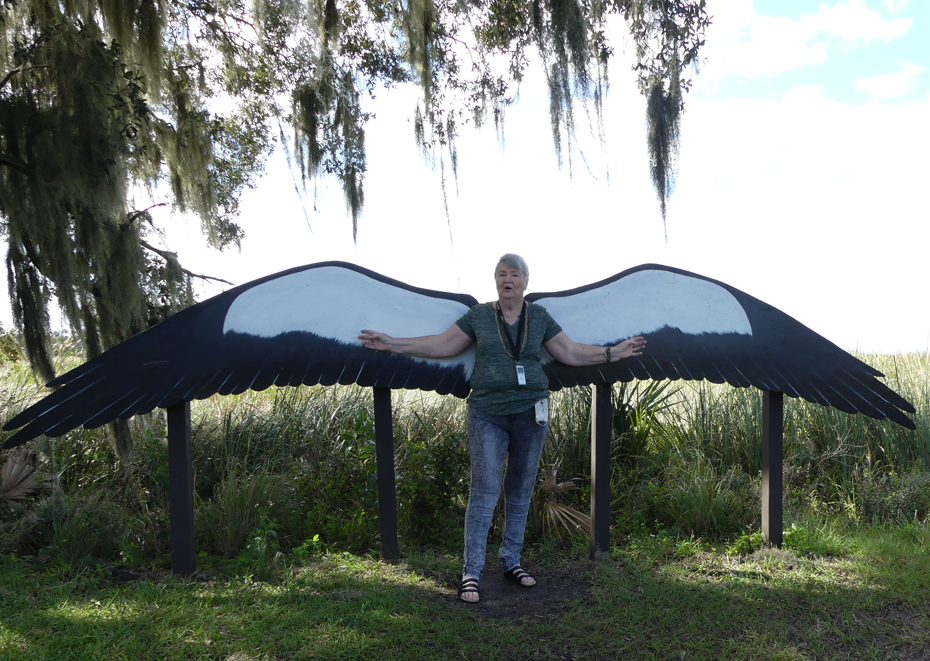
Some other wings you
will find here for sure are West Volusia's
artist in residence, Erica Group's,
Swallow-Tailed Kite Wings. They are part
of the “Wings of The West”, a series of six
wings murals around the county. Each set of
wings represents something about the location
where they’re located.
DeLeon Springs
State Park
Nearby you can visit
DeLeon Springs State Park. There is no way of
knowing if Bartram visited this spot but if he
had he would have loved the spring with
a constant 72 degrees and depths range from 18
inches to 30 feet.
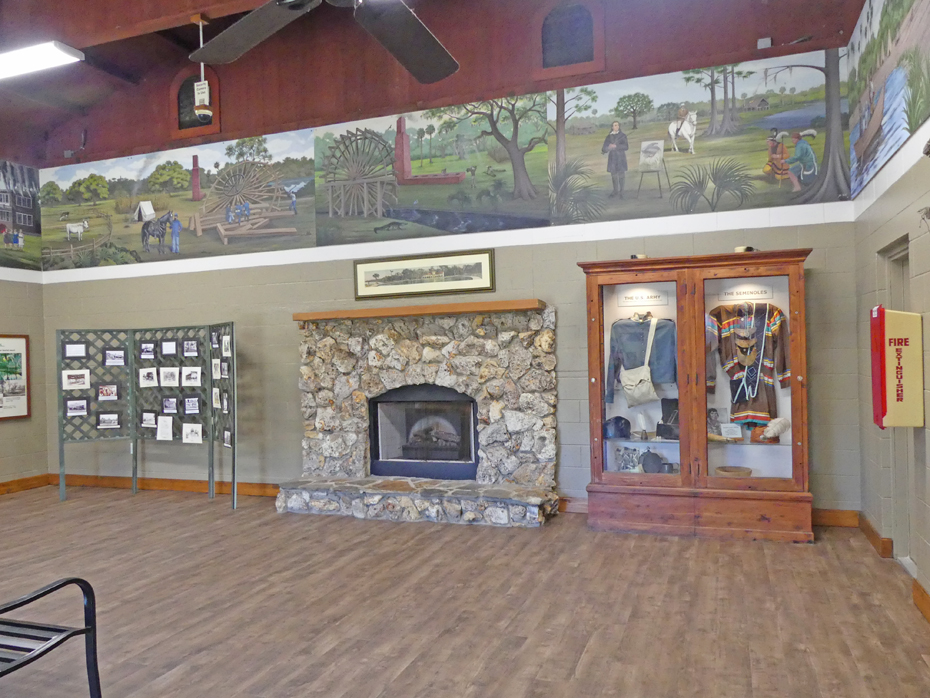
The Visitor's Center at the park has exhibits
that show that people lived here for over 6,000
years. These earliest recorded dwellers were the
Mayaca. Evidence of their lifestyle was found in
shell mounds they left behind. The site
was once a plantation and during the 1950-60s, a
resort. During the height of the attractions'
era, there was even a water skiing elephant
called Sunshine Sallie.
The park is on the Great
Florida Birding and Wildlife Trail. You have a
choice of the Wild Persimmon Hiking Trail, a
four-mile loop, where you might spot deer,
turkeys, wild hogs and Florida black bears, or
the half-mile paved wheelchair-accessible nature
trail. Had Bartram passed here he might have
seen a 300 plus-year-old cypress tree. Today, it
is more than 600 years old.
If you are on the water,
you can canoe or kayak into Lake Woodruff
National Wildlife Refuge. Another water
adventure here is the 50-minute eco/history boat
tour on Spring Garden Run aboard the M/V Acuera.
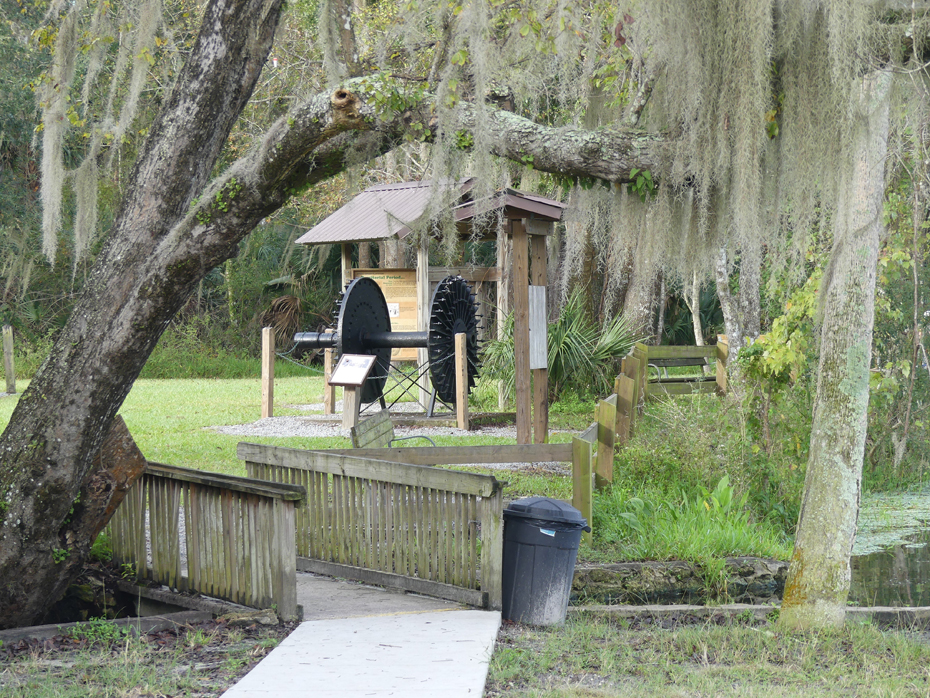 |
| A remnant of
the old mill surrounded by Spanish moss
draped from the oak trees |
There is a unique
restaurant here, Old Spanish Sugar Mill Restaurant that is
perfect for breakfast. The restaurant is built
on the remains of a sugar-making operation from
the 1830s. Remnants of the mill, the
brickwork, boiling kettles, mill machinery, and
the original mill wheel hub are located behind
the restaurant. The tables are each equipped
with a griddle where you can make your own
pancakes. The waitress brings you pitchers of
batter and your choice of add-ins. You just
pour, flip, and enjoy.
Hontoon Island
State Park
Hontoon Island State
Park can only be reached by boat. Bartram
described it as "A delightful little bluff
consisting chiefly of shells." It was here he
sheltered as best he could from the hurricane
writing that it was "a large islet or grove of
Oaks and Palms. Here I intended to seek shelter,
and abide till the fury of the hurricane was
overpast."
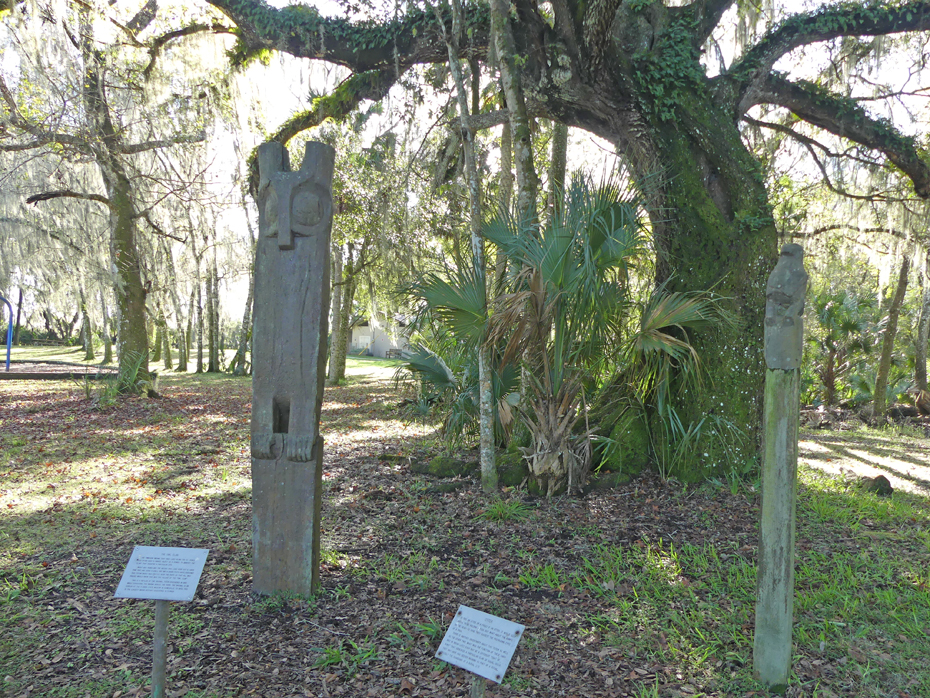 |
| Totem replicas
of the Owl and a smaller one that is
believed to be either a frog or an otter |
The shells were most
likely the remnants of the Timucuan settlement
once here. Today, there is an Owl Totem replica.
The original was recovered in 1955 and is in the
Florida State Museum in Gainesville. The totem's
located between the visitor's center and the
playground/area. The Timucuan used the totems to
show which clan lived in an area.
The interpretive center
tells the history of the island and the wildlife
you might see. You can camp there, stay in a
primitive cabin, or rent a kayak, canoe, or
bicycle to explore the island. Rene Acuna, Park
Manager who showed us around the island, told us
he had seen a bear just a few days ago.
Naturally, being an island you might see an
alligator and lots of wildlife.
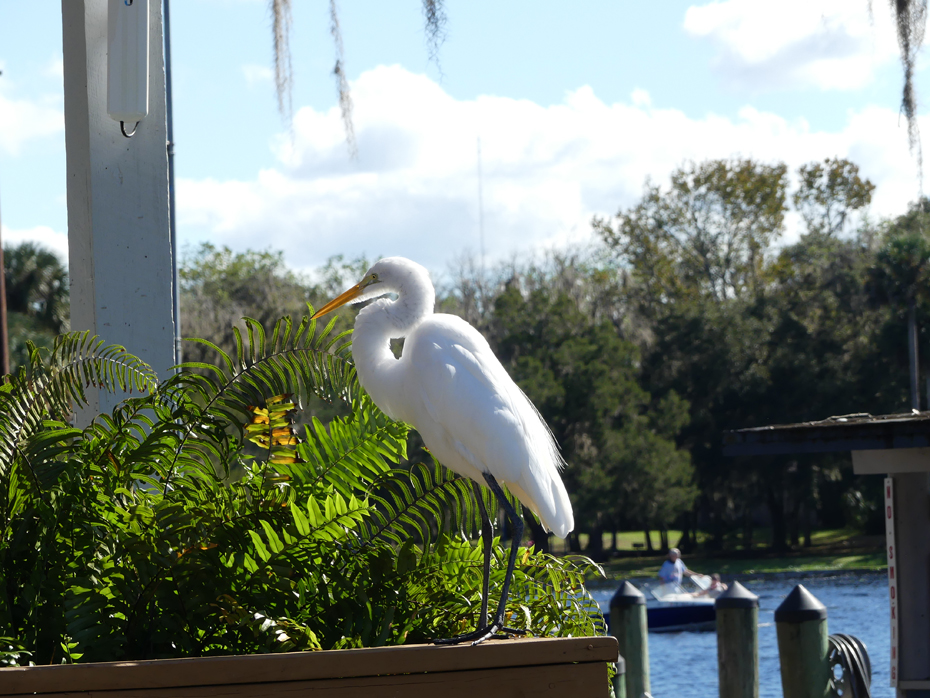 |
| Egret at
Hontoons Landing |
There's a good place for
lunch just across from the park, Hontoon Landing
Deli. Aside from a great sandwich, you might
meet two sand hill cranes near the outside
dining area in front or an egret perched on the
rail while you dine overlooking the water in
back.
Blue Spring
State Park
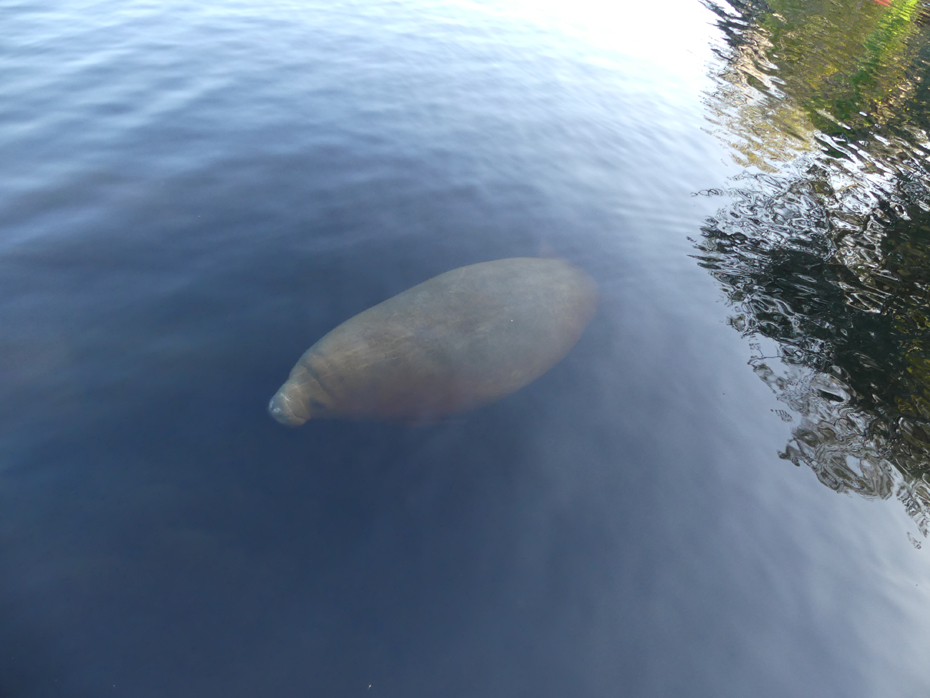
West Volusia, being such
an outdoor treasure, has three state parks. Blue
Spring is the most famous as a manatee area.
They come into the spring beginning in November
and stay for the winter months. The spring
remain at 72 degrees year-round, and the
manatees are sensitive to the cold so as Saint
Johns River cools this is one of their favored
refuges.
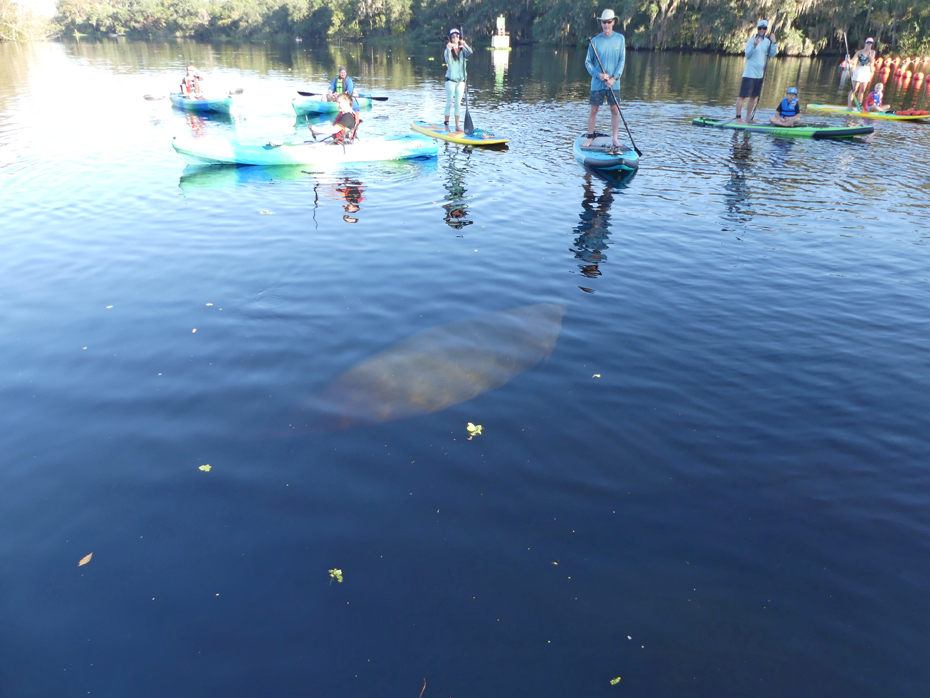 |
| For the safety
of the manatees, people must maintain a
distance of at least 50 feet |
While Bartram was
staying at the Beresford Plantation recovering
from his brush with the hurricane, Charles
Bernard, the caretaker and good friend, took him
to visit Blue Spring. Bartram found the spring
water to have "a most disagreeable taste." He
describes the spring as "boils up with great
force, forming immediately a vast circular
bason, capacious enough for several shallops to
ride in, and runs with rapidity into the river
three or four hundred yards distance."
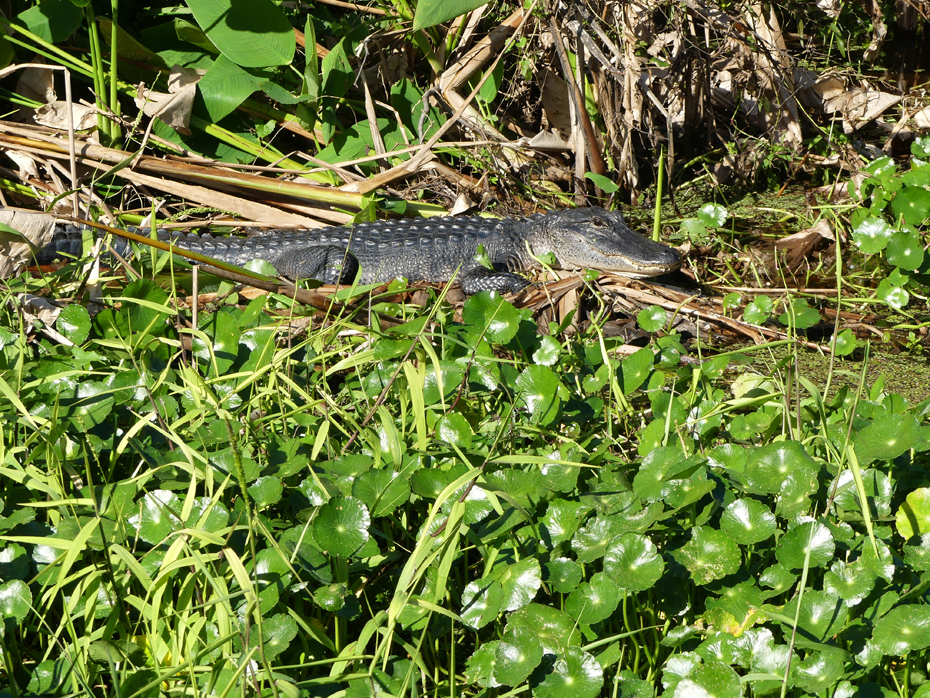 |
| A small
alligator, one of many seen from the
boat tour |
Since he was here during
hurricane season, he was not lucky enough to see
any manatees. He was dead on about the size,
however. It is the largest first magnitude
spring emptying about 100 million gallons of
water a day into the river. When we visited in
late November, we saw about ten manatees.
Ranger Darrell Thomas took us on a tour of the
park. From November 15 to March 30, the run is
closed to swimming and human water fun. It is
reserved for the manatees.
He told us that when
Jacques Cousteau came in 1971 and did a
documentary called The Forgotten Mermaid that
put Blue Spring on the map for visitors. The
following year it became a state park. Darrell
said, "When Jacques Cousteau came here there
were about 10 or 11 manatees, and this past
season we broke our record, and there were 583
manatees."
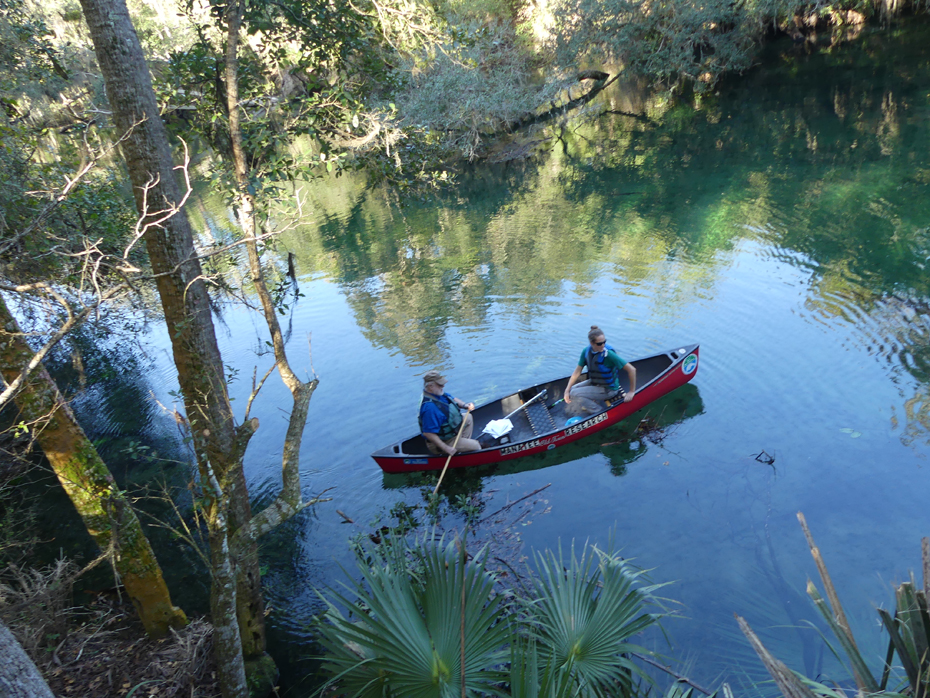 |
| Wayne Hartley
and assisant doing a manatee count at
Blue Spring |
Interestingly the
manatees are named. Their genealogy is traced
letting science learn so much more about their
habits. One man, Wayne Hartley, has traced
manatee families and named them for over four
decades. I was fortunate enough to meet him on
this trip as he was doing his daily manatee
count.
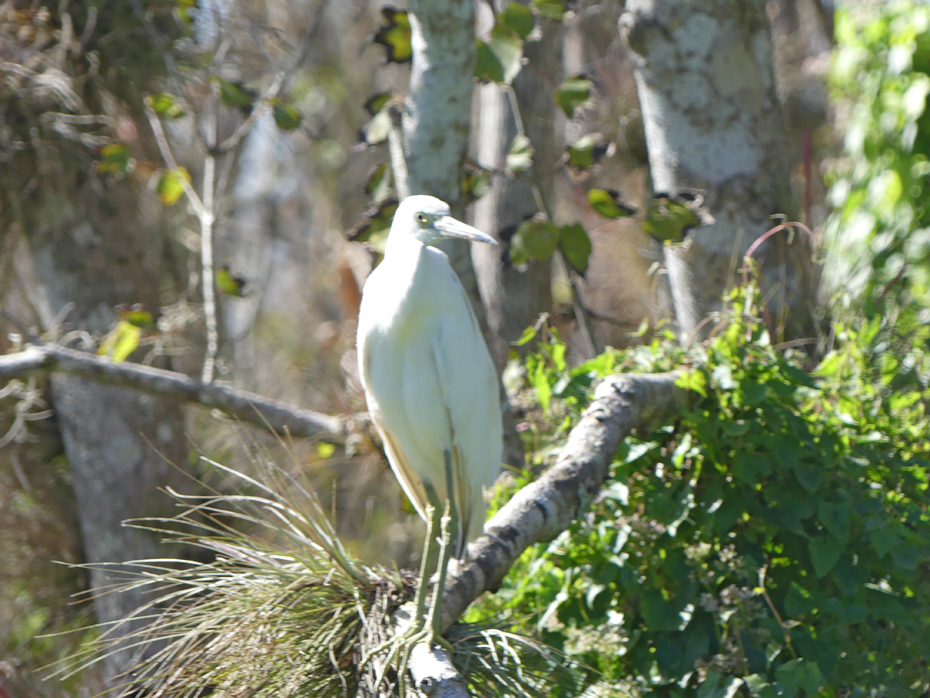 |
| A baby great
blue heron that has not turned blue yet |
When you visit I highly
recommend you take the Blue Spring Adventure
pontoon boat tour and if possible get Captain
Rebecca. On the two hour tour through the Saint
Johns River, she was able to identify all of the
birds and told educational and entertaining
information about the river and the wildlife.
Did you know the young little blue heron is
white for the first year of life?
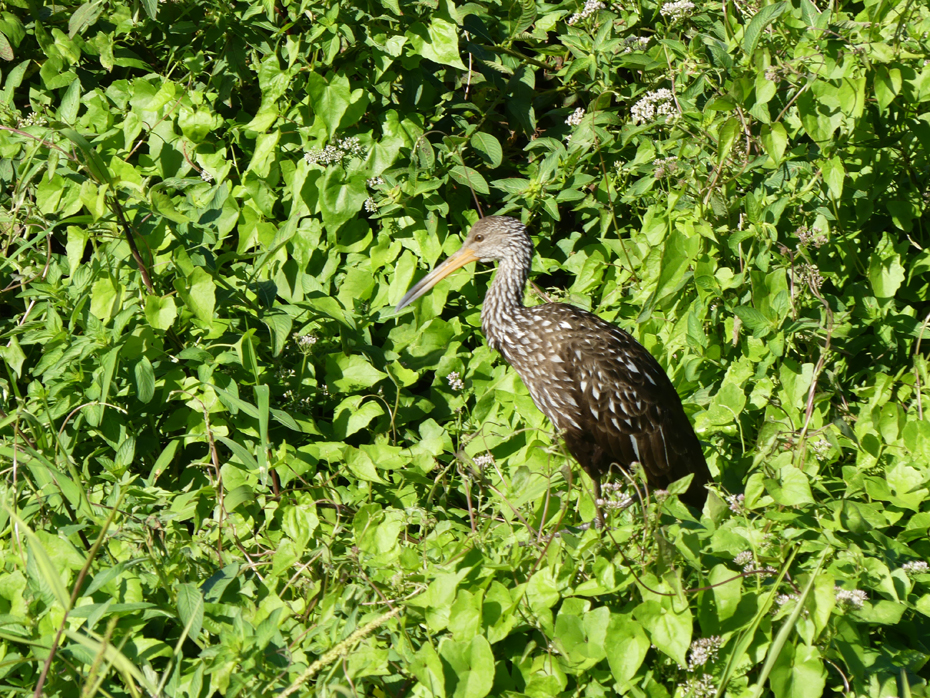 |
| A limpkin
also called "the crying bird" |
We saw birds of all
kinds and ages. The limpkin, a well-camouflaged
brown bird, sometimes called the crying bird,
because of its call, lives in the shallows of
the river. Rebecca told us it's screaming call
was used in the early Tarzan movies when you
believe you are hearing Cheetah's voice. We
also saw plenty of alligators, turtles, giant
herons, egrets, ibises, wood storks, and so many
more.
Aside from the natural
aspects of the park, there is the Thursby House
built in 1872 by Louis Thursby, one first
European settlers, in the area although
primitive people lived here for thousands of
years previously. In fact, he built his home on
top of one of the early middens. The location on
the St. Johns River gave him a means of shipping
the oranges he grew here.
The park offers camping
and cabins.
Lyonia
Environmental Center
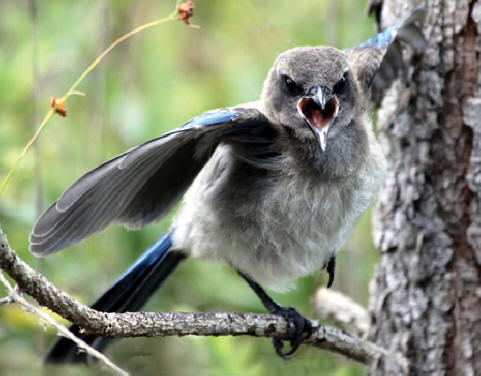 |
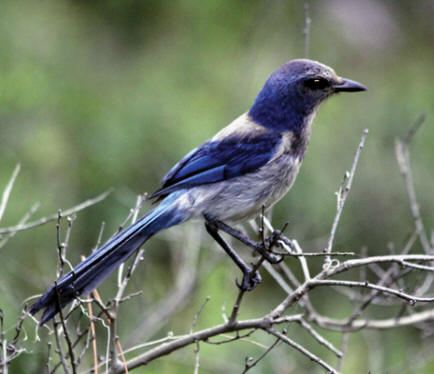 |
| Baby scrub jay |
Adult scrub jay |
Lyonia Environmental
Preserve's 360 acres are a bit inland so perhaps
Bartram did not get here. That's his loss. It is
rich in wildlife and one of the few places you
might see a Florida scrub jay. These birds are
on the Threatened List and live only in central
Florida. They have an unusual family system
where the juvenile from the last hatching hang
around to offer protection as an extra set of
eyes watching for predators while the next
babies hatched. They need a scrub environment,
which is also a developer's favorite land type.
Sandy Falcon, Center manager, led us through the
preserve. It's an easy hike as the trails are
wide and not very hilly.
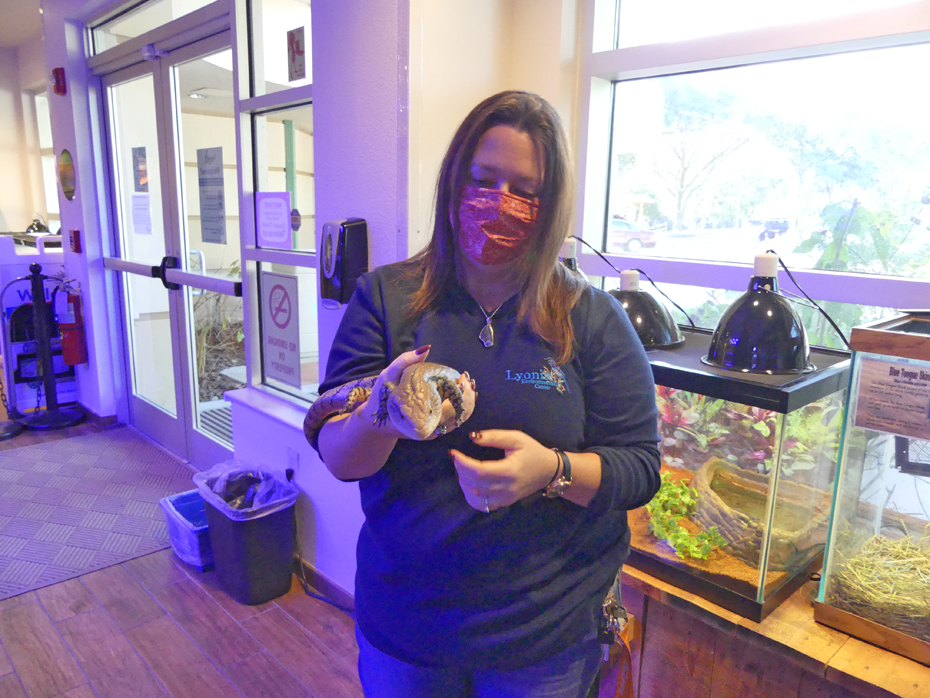 |
| Sandy holding
the blue tongued skink |
Inside the center, there
are a lot of interpretive exhibits and some real
wildlife including some king snakes, a ball
python, a pair of turtles named Tuttie and
Frutti, a few fish in the turtle tank that were
intended as food but survived and now share the
tank, a blue-tongued skink named Igor, and more.
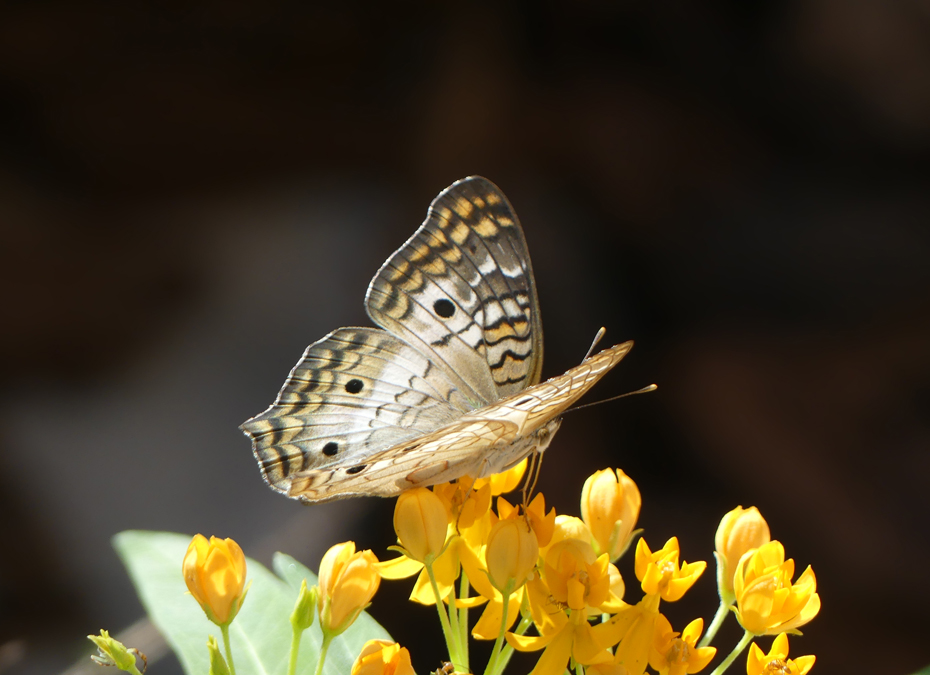 |
|
White peacock butterfly in garden at
preserve |
Outside, adjacent to the
beautiful butterfly garden, you find another set
of wings, the Scrub Jay Wings from the Wings of
the West series.
Gemini Springs
William and his father,
John Bartram, described Gemini Spring as "having
three heads within 30 yards" and covered with
"duck meat," the term then used to describe duck
weed.
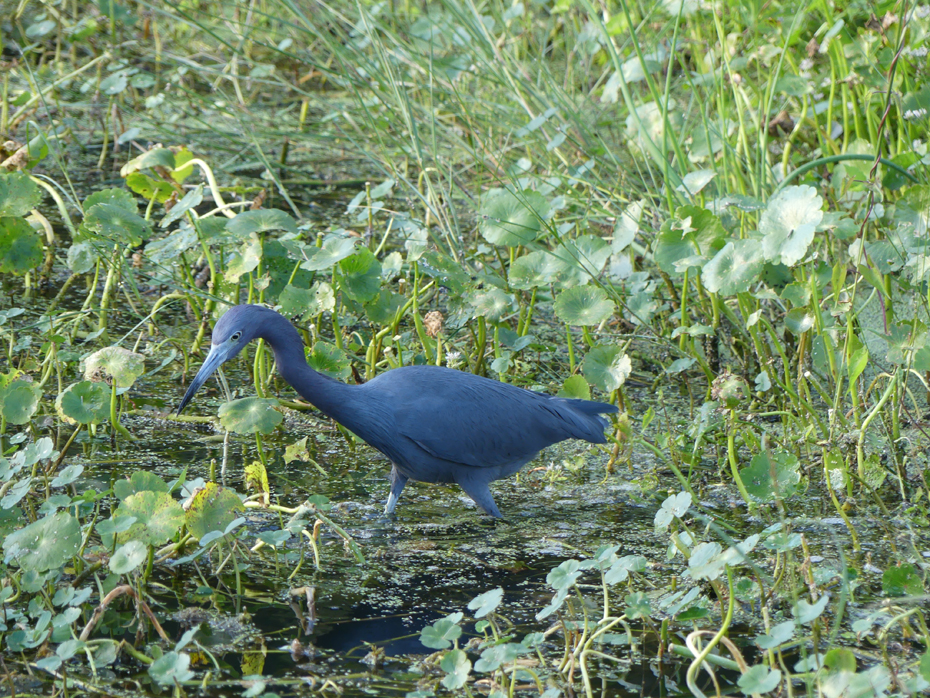
It's a 212-acre park
today that pumps about 6.5 million gallons of
sparkling fresh water up from the two springs
each day. I spotted a large flock of Florida
white ibises there browsing around the spring.
Another bird, a beautiful blue heron, was
grazing among what Bartram may have referred to
as "duck meat."
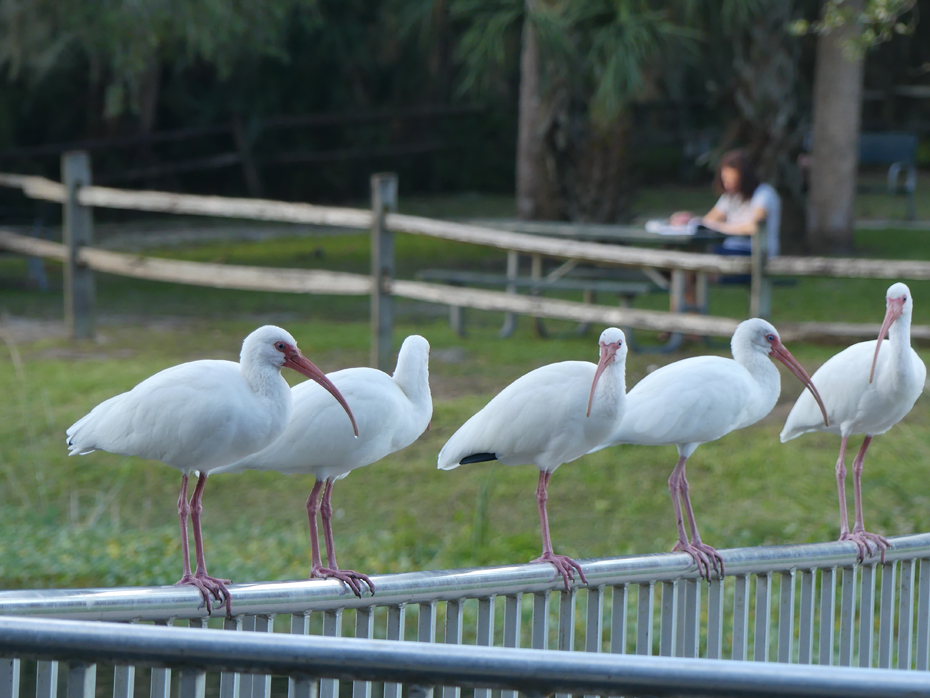 |
| A flock of
ibises perching on a railing |
The park had a nice
paved trail that wanders across the spring run
as well as several wooded trails. There are a
campground, a dog park and lots of picnic
tables.
Green Springs
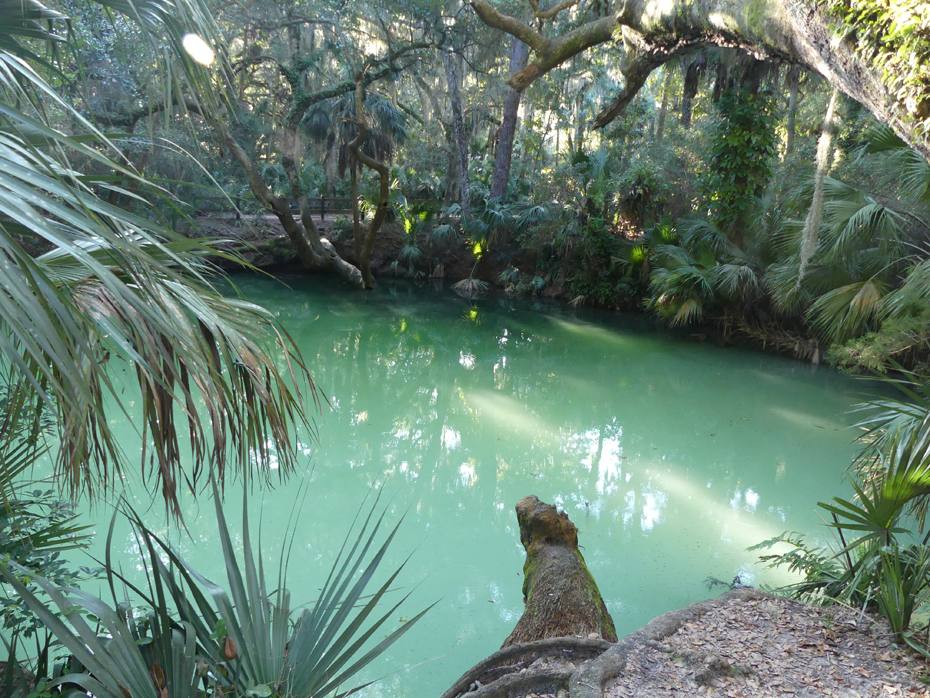
Green Springs looks like
a small emerald dropped into the forest. John
and William Bartram described it as a "pretty
stream of sweet water." It's one of Florida's
few sulfur springs which Native Americans
considered sacred and believed it had healing
power.
It was once part of Baron Fredrick DeBary's
hunting estate. You can tour DeBary's home but
that'll be another story.
For those when want to follow William Bartram by
water, there is a map at the link below that
shows the sites you can travel to by water.
For more info:
https://floridascenichighways.com/wp-content/uploads/2016/09/Bartram-Trail-Along-ROLHC-Map-Brochure.pdf
https://visitwestvolusia.com/
|

